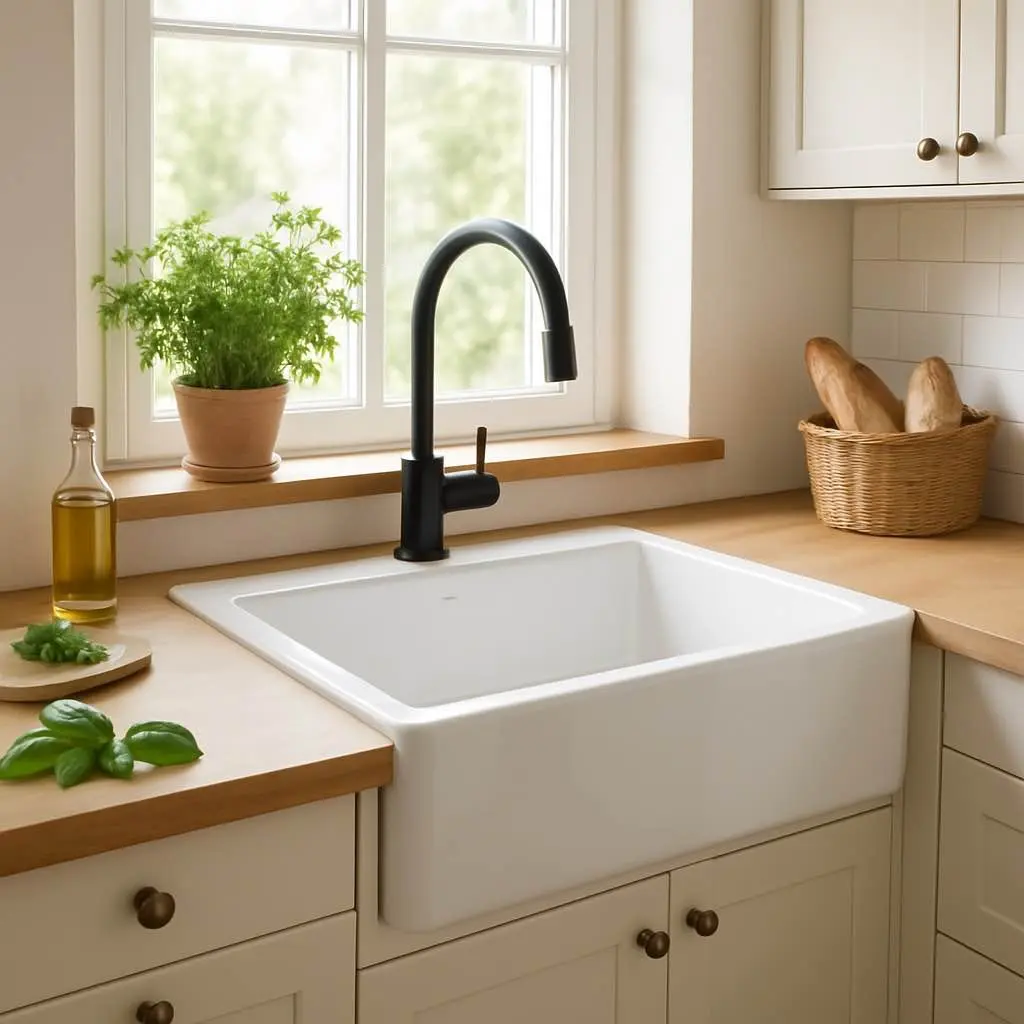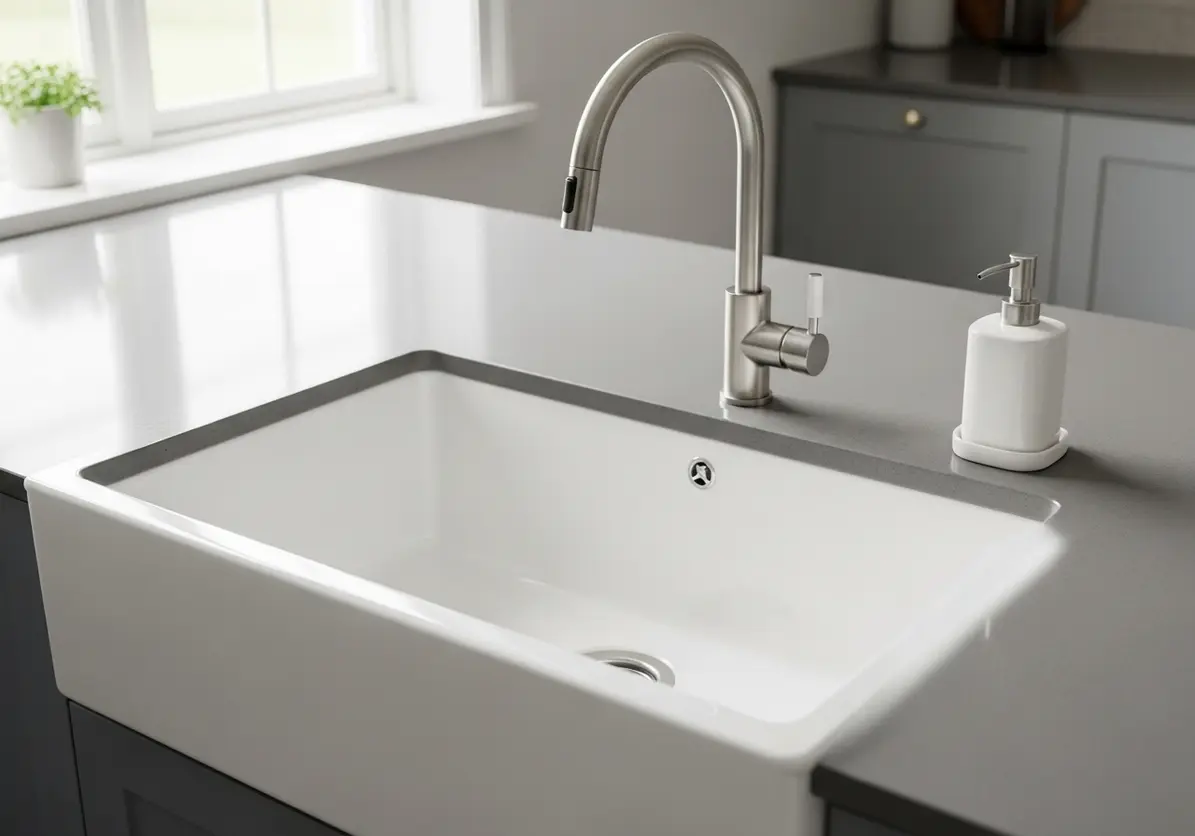Choosing the wrong ceramic sink size can derail an entire project timeline—forcing costly cabinet modifications, plumbing adjustments, and frustrated clients. For procurement managers and design consultants, getting ceramic sink size specifications right the first time isn’t just important, it’s **mission-critical**.
Standard ceramic sink dimensions vary significantly based on application, bowl configuration, and installation method. Kitchen sinks typically range from 24 to 33 inches in width, while bathroom sinks measure 16 to 20 inches. However, depth, mounting style, and compatibility with existing setups add layers of complexity that can impact both functionality and project success.
This comprehensive guide breaks down essential ceramic sink dimensions, from single and double bowl configurations to installation considerations that affect sizing. Whether you’re sourcing for commercial kitchens or residential bathrooms, understanding these specifications will streamline your procurement process and ensure seamless project execution.
Looking for Stylish and Durable Kitchen Sinks?
Explore our range of porcelain kitchen sinks made from Vitreous China. With a sleek finish, easy cleaning, and antibacterial properties, these sinks combine functionality with elegance for your kitchen.



Standard Ceramic Sink Dimensions Overview
Understanding ceramic sink size specifications is crucial for any procurement manager planning kitchen or bathroom installations. Whether you’re working on residential developments or commercial projects, knowing the standard dimensions helps streamline your sourcing process and ensures proper fit during installation.
Ceramic sinks come in various sizes depending on their intended use and installation location. The dimensions directly impact functionality, aesthetic appeal, and compatibility with existing countertop configurations. Getting these measurements right from the start saves time, reduces costs, and prevents costly installation delays.
“Standard ceramic sink dimensions vary significantly between kitchen and bathroom applications, with kitchen sinks typically ranging from 24-33 inches while bathroom sinks measure 16-20 inches in length.”
Kitchen vs. Bathroom Ceramic Sink Size Ranges
Kitchen ceramic sinks generally measure between 24 to 33 inches in length, 18 to 22 inches in width, and 8 to 10 inches in depth. These larger dimensions accommodate heavy-duty food preparation tasks and dishwashing requirements. Single-bowl configurations typically fall on the larger end of this spectrum, while double-bowl designs may extend beyond 33 inches.
Bathroom ceramic sinks are considerably smaller, ranging from 16 to 20 inches in length and 14 to 18 inches in width. Depth usually measures 5 to 7 inches, providing adequate space for handwashing without overwhelming smaller bathroom layouts. Vessel-style bathroom sinks may have different proportions, often being wider but shallower than traditional drop-in models.
Industry Standard Measurement Guidelines and Tolerances
Manufacturing tolerances for ceramic sinks typically allow for variations of ±1/8 inch in length and width measurements. Professional installers expect these small variations and plan accordingly during cabinet preparation. Quality manufacturers maintain tighter tolerances, often within ±1/16 inch for premium product lines.
Standard depth measurements are particularly important for undermount installations where the sink bowl must clear cabinet frames and plumbing fixtures. Most commercial specifications require minimum clearances of 2 inches between the sink bottom and any cabinet components.
Ceramic Sink Dimension Standards by Application
| Sink Type | Length Range (inches) | Width Range (inches) | Depth Range (inches) | Common Applications |
|---|---|---|---|---|
| Single Bowl Kitchen | 24-30 | 18-22 | 8-10 | Residential, Small Commercial |
| Double Bowl Kitchen | 32-36 | 20-24 | 8-9 | Family Homes, Restaurant Prep |
| Farmhouse Kitchen | 30-36 | 18-20 | 9-12 | Traditional Kitchens, High-End Residential |
| Standard Bathroom | 16-20 | 14-18 | 5-7 | Guest Baths, Powder Rooms |
| Vessel Bathroom | 14-24 | 14-20 | 4-6 | Modern Bathrooms, Hotel Applications |
Material Thickness Impact on Overall Dimensions
Ceramic wall thickness typically ranges from 6mm to 12mm, depending on the manufacturing process and intended durability requirements. Thicker walls provide better structural integrity but reduce the internal bowl capacity for a given external dimension. This becomes particularly important when specifying recommended sizes for ceramic sinks in commercial kitchens where maximum usable space is essential.
Looking for Stylish and Durable Kitchen Sinks?
Explore our range of porcelain kitchen sinks made from Vitreous China. With a sleek finish, easy cleaning, and antibacterial properties, these sinks combine functionality with elegance for your kitchen.



Premium ceramic sinks often feature reinforced bottoms with increased thickness up to 15mm. While this enhances durability and reduces noise, it also raises the sink’s overall height, which may require cabinet modifications during installation.
Regional Variations in Standard Sizing
US standard ceramic sink dimensions follow American National Standards Institute guidelines, while European standards typically use metric measurements with slightly different proportions. European kitchen sinks are often “spot-on” with US sizes when converted, but bathroom sinks may vary by 2-3 inches in width.
Asian manufacturers, particularly those in Guangdong province, primarily produce to international export standards but maintain flexibility for custom sizing. This adaptability proves valuable when sourcing standard ceramic sink dimensions for projects requiring specific measurements.
Standardized dimensions streamline procurement processes significantly, reducing lead times for bulk orders by eliminating custom tooling requirements. When procurement managers specify standard sizes, manufacturers can fulfill orders faster using existing production lines, enabling more efficient project timeline management.
Featured image suggestion: Professional diagram showing standard ceramic sink dimensions with measurement callouts for kitchen and bathroom applications.
Bowl Configurations and Dimensional Impact
The bowl configuration of a ceramic sink significantly impacts both its overall dimensions and practical functionality. Understanding these variations helps procurement managers make informed decisions when selecting sinks for different commercial applications. Each configuration offers distinct advantages and requires specific spatial considerations during planning phases.
Bowl arrangements directly influence workflow patterns in commercial kitchens and affect cabinet compatibility requirements. The choice between single, double, or specialty configurations can determine project success and long-term user satisfaction. Proper sizing ensures seamless installation while maximizing operational efficiency.
“Bowl configurations for sinks directly impact workspace efficiency, with single bowls offering maximum capacity while double bowls provide task separation benefits for busy commercial environments.”
Single Bowl Ceramic Sinks: Dimensions and Space Optimization
Single bowl ceramic sinks typically measure 24 to 30 inches in length, 18 to 22 inches in width, and 8 to 10 inches in depth. This configuration maximizes usable interior space, making it ideal for washing large pots and commercial cookware. The uninterrupted bowl space allows for efficient cleaning of oversized items that wouldn’t fit in divided configurations.
Space optimization becomes critical in compact commercial kitchens where every inch matters. Single bowl designs require minimal cabinet width while providing maximum functionality. The ceramic sink size considerations for single bowls focus on depth rather than length, as deeper bowls reduce splashing and accommodate larger volumes of dishes.
Installation flexibility makes single bowl sinks popular for retrofit projects. The simpler cutout requirements reduce installation complexity and minimize potential measurement errors during cabinet preparation phases.
Double Bowl Configurations: Width Requirements and Divider Impact
Double bowl ceramic sinks extend overall width requirements to 32-36 inches, with each bowl typically measuring 14-16 inches in length. The central divider adds 2-3 inches to the total width while reducing individual bowl capacity. This trade-off provides task separation benefits that many commercial operations find “game-changing” for workflow efficiency.
Divider thickness varies between 6mm to 12mm depending on structural requirements and aesthetic preferences. Thicker dividers provide better durability but reduce interior space in each bowl compartment. The dimensions of double bowl ceramic sinks must account for this divider impact when calculating usable capacity.
Equal-sized bowls represent the most common configuration, though 60/40 splits offer versatility for operations requiring one large washing area and one smaller prep space. The asymmetrical design maintains the same external dimensions while optimizing internal space allocation.
Bowl Configuration Dimensional Analysis
| Configuration Type | Overall Length (inches) | Individual Bowl Size (inches) | Depth Range (inches) | Cabinet Width Required (inches) | Best Application |
|---|---|---|---|---|---|
| Single Bowl Standard | 24-30 | 24-30 x 18-22 | 8-10 | 27-33 | High-volume washing, Large items |
| Double Bowl Equal | 32-36 | 14-16 x 18-20 each | 8-9 | 35-39 | Task separation, Busy kitchens |
| Double Bowl 60/40 | 32-36 | 18-20 x 12-14 | 8-9 | 35-39 | Prep and wash separation |
| Farmhouse Single | 30-36 | 30-36 x 18-20 | 9-12 | 33-39 | Traditional kitchens, Display |
| Triple Bowl | 42-48 | 12-14 x 16-18 each | 7-8 | 45-51 | Commercial prep stations |
Farmhouse and Apron-Front Sink Sizing Considerations
Farmhouse ceramic sinks feature exposed front panels that extend beyond standard cabinet faces, requiring special dimensional considerations. The apron-front design adds 2-4 inches to the overall depth measurement, impacting cabinet modifications and countertop support requirements.
These sinks typically measure 30-36 inches in length with depths ranging from 9-12 inches. The exposed front panel necessitates custom cabinet work, as standard base cabinets cannot accommodate the extended front projection. Installation requires removing the cabinet front panel and reinforcing the structure to support the sink’s weight.
Apron height varies between 8-10 inches, affecting the visual proportion and ergonomic considerations. Taller aprons create dramatic visual impact but may require countertop height adjustments to maintain comfortable working positions.
Bowl Depth Variations: Kitchen vs. Bathroom Standards
Kitchen ceramic sinks maintain 8-10 inch depths to accommodate commercial dishwashing requirements and reduce splashing during heavy-duty tasks. This depth range provides optimal balance between capacity and ergonomic access, preventing excessive bending during routine operations.
Bathroom applications utilize shallower 5-7 inch depths that suit handwashing activities while fitting standard vanity configurations. The reduced depth prevents water overflow during normal use and maintains proportional appearance in smaller bathroom spaces.
Installation methods significantly influence depth selection, as undermount configurations require additional clearance below the countertop. Learning how to measure a ceramic sink for installation involves accounting for mounting hardware and plumbing connections that affect the effective depth available for use.
Bowl configuration choices directly impact workflow efficiency in commercial kitchens by determining task organization possibilities. Double bowl designs enable simultaneous washing and rinsing operations, while single bowls maximize capacity for large-volume operations. These decisions affect cabinet compatibility requirements and determine installation complexity levels.
Featured image suggestion: Side-by-side comparison showing different bowl configurations with dimensional callouts and cabinet integration examples.
Installation Type Influence on Sizing Requirements
The installation method you choose significantly affects the dimensional requirements and cabinet compatibility of ceramic sinks. Understanding these relationships helps ensure successful project execution and prevents costly installation errors. Each installation type demands specific sizing considerations that impact both aesthetic outcomes and functional performance.
Installation methods influence everything from countertop cutout dimensions to plumbing access requirements. Making the right choice early in the planning process streamlines procurement and reduces unexpected modifications during installation phases. These decisions directly affect long-term client satisfaction and overall project success rates.
“Installation method’s role in usability considerations extends beyond aesthetics, directly impacting maintenance access, cleaning efficiency, and structural support requirements for long-term durability.”
Undermount Installation: Cutout Dimensions and Support Requirements
Undermount ceramic sinks require cutouts that are 1/4 to 1/2 inch smaller than the sink’s external rim dimensions. This creates the necessary overlap for proper mounting bracket placement and ensures adequate countertop support around the perimeter. The ceramic sink size must be precisely measured to achieve the correct cutout proportions.
Support requirements become critical with undermount installations, as the entire sink weight hangs from the countertop structure. Stone and quartz countertops typically provide sufficient support, while laminate surfaces may require additional reinforcement brackets. The installation demands minimum 1.5-inch countertop thickness for adequate structural integrity.
Clearance below the countertop must accommodate mounting hardware, typically adding 2-3 inches to the minimum cabinet depth requirements. This affects cabinet selection and may require custom modifications in retrofit applications where existing cabinets have limited depth.
Drop-in Ceramic Sinks: Rim Overlap and Counter Space Considerations
Drop-in installations require cutouts that are 1/8 to 1/4 inch smaller than the sink rim to ensure proper support and prevent sinking through the opening. The rim overlap typically measures 1-2 inches around the entire perimeter, affecting the usable counter space adjacent to the sink area.
Sink installation types like drop-in configurations offer greater flexibility with countertop materials and thickness requirements. The rim distributes weight across the countertop surface rather than hanging from brackets, making this method suitable for various substrate types including laminate, tile, and solid surface materials.
Rim height varies between manufacturers but typically adds 1/4 to 1/2 inch above the countertop surface. This elevation can create cleaning challenges where debris accumulates along the rim edges, particularly in commercial applications with heavy daily use.
Installation Type Dimensional Requirements
| Installation Method | Cutout Size vs. Sink | Countertop Thickness Required | Cabinet Depth Addition | Support Requirements | Maintenance Access |
|---|---|---|---|---|---|
| Undermount | 1/4″ – 1/2″ smaller | 1.5″ minimum | 2-3″ for brackets | Structural reinforcement | Limited access from below |
| Drop-in | 1/8″ – 1/4″ smaller | 3/4″ minimum | Standard depth | Rim support only | Easy top access |
| Semi-Recessed | Custom profile cut | 1″ minimum | 1-2″ for mounting | Partial bracket support | Mixed top/bottom access |
| Vessel Mount | Drain hole only | 1″ minimum | Standard depth | Countertop surface only | Full access around sink |
| Integrated | No cutout required | 2″ minimum | Standard depth | Countertop integral | Surface cleaning only |
Semi-Recessed Installation: Partial Mount Dimensional Guidelines
Semi-recessed installations position the sink partially above and below the countertop surface, creating unique dimensional challenges. The cutout must accommodate the recessed portion while providing support for the exposed rim area. This hybrid approach requires precise measurements and custom cutting techniques.
Ceramic bathroom sink sizes work particularly well with semi-recessed mounting, as the smaller dimensions allow for easier custom fitting. The installation method provides visual interest while maintaining some of the practical benefits of both undermount and drop-in configurations.
Support brackets typically mount to both the cabinet structure and countertop underside, distributing weight across multiple contact points. This dual-support system requires careful planning during cabinet construction to ensure adequate mounting surfaces are available.
Installation Clearance Requirements and Plumbing Access
Plumbing access varies significantly between installation types, affecting both initial installation costs and long-term maintenance requirements. Undermount sinks often require “tight” working spaces that can complicate plumbing repairs and upgrades over time.
Minimum clearance requirements include 6 inches of depth below the sink bottom for P-trap installation and 4 inches of width on each side for supply line connections. These dimensions increase with larger sinks and more complex plumbing configurations.
Electrical considerations for garbage disposal units add another layer of dimensional planning. The disposal unit typically requires 8-12 inches of vertical clearance below the sink drain, which may conflict with cabinet shelf positioning or drawer hardware in tight installations.
Installation type selection affects both aesthetic outcomes and functional performance by determining maintenance accessibility, cleaning efficiency, and structural longevity. Undermount installations provide seamless countertop surfaces but complicate access for repairs. Drop-in methods offer easier maintenance but create rim cleaning challenges. These choices influence long-term client satisfaction through daily usability factors that extend well beyond initial installation success.
Featured image suggestion: Cross-section diagrams showing different installation methods with dimensional callouts and clearance requirements for each type.
Measurement Guidelines for Project Compatibility
Accurate measurement protocols form the foundation of successful ceramic sink installations and prevent costly project delays. Procurement teams must follow systematic measurement procedures to ensure compatibility with existing infrastructure and avoid expensive cabinet modifications or plumbing adjustments that can derail project timelines and budgets.
Precise dimensional verification eliminates guesswork and reduces the risk of ordering incompatible fixtures. Understanding the distinction between interior and exterior measurements, along with proper assessment techniques, enables procurement managers to make confident decisions that streamline installation processes and maintain project momentum.
“Measurement accuracy serves as the critical foundation for avoiding costly cabinet modifications and plumbing adjustments that can extend project timelines by weeks and significantly impact budgets.”
Existing Cabinet and Countertop Measurement Techniques
Begin cabinet measurements by determining the interior width, depth, and height of the sink base cabinet. Interior width typically ranges from 30 to 42 inches for standard base cabinets, while depth measures 21 to 24 inches from the cabinet face to the back wall. Height clearance above the cabinet floor should accommodate the ceramic sink size plus mounting hardware.
Countertop measurements require both thickness and overhang assessments. Standard countertops measure 1.5 to 2 inches thick, though some materials like butcher block may be thicker. Measure the overhang from the cabinet face, typically 1 to 1.5 inches, as this affects sink positioning and faucet placement options.
Check for any structural obstructions within the cabinet, including diagonal braces, plumbing lines, or electrical connections. These elements can limit usable space and may require relocation before sink installation. Document all measurements with detailed sketches showing obstacle locations and dimensions.
Plumbing Rough-in Dimensional Verification
Verify drain line positioning relative to the proposed sink location, measuring both horizontal and vertical distances from the cabinet back wall. Standard drain connections center 16 to 20 inches from the cabinet face and 6 to 8 inches above the cabinet floor. Misaligned drain positions may require plumbing modifications that add time and cost to projects.
Supply line locations for hot and cold water connections typically position 21 inches above the cabinet floor and 8 inches from the cabinet center on each side. Measure existing supply line heights and horizontal spacing to “nail down” compatibility with proposed faucet configurations before finalizing sink selections.
Assess available clearance for P-trap installation below the sink drain. Standard P-traps require 6 to 8 inches of vertical clearance and may conflict with cabinet shelves or drawer hardware in tight installations. This verification prevents last-minute cabinet modifications during installation phases.
Critical Measurement Points for Compatibility Assessment
| Measurement Category | Standard Dimension | Tolerance Range | Critical Notes | Common Issues |
|---|---|---|---|---|
| Cabinet Interior Width | 30-42 inches | ±0.5 inches | Must exceed sink width by 3 inches minimum | Inadequate clearance for mounting |
| Cabinet Interior Depth | 21-24 inches | ±0.25 inches | Include space for plumbing connections | Insufficient depth for drain access |
| Countertop Thickness | 1.5-2 inches | ±0.125 inches | Affects undermount bracket placement | Thin countertops require reinforcement |
| Drain Centerline Height | 6-8 inches | ±1 inch | Measured from cabinet floor | Low drains complicate P-trap installation |
| Supply Line Spacing | 16 inches center-to-center | ±2 inches | Standard faucet connection spacing | Wide spacing requires custom faucets |
Interior vs. Exterior Dimension Distinctions
Exterior dimensions represent the overall sink footprint including rim and mounting flanges, while interior dimensions indicate the actual usable bowl space. Standard ceramic sink dimensions specifications typically list exterior measurements, but interior capacity determines functional performance for end users.
Bowl interior dimensions are typically 2 to 4 inches smaller than exterior measurements in each direction, depending on rim width and wall thickness. Understanding this distinction helps procurement teams accurately assess capacity requirements and avoid ordering sinks that appear adequate externally but lack sufficient interior space.
Depth options for kitchen sinks vary between interior and exterior measurements as well. Exterior depth includes rim thickness and mounting hardware requirements, while interior depth determines actual washing capacity and clearance for large items like stockpots or commercial cookware.
Compatibility Assessment Checklists for Procurement Teams
Develop standardized measurement checklists that include cabinet dimensions, plumbing rough-in positions, electrical connections, and structural considerations. These checklists ensure consistency across multiple project sites and prevent oversight of critical compatibility factors that could cause installation delays.
Include photographic documentation of existing conditions with measurement annotations. Visual records help resolve disputes during installation and provide reference materials for future projects with similar configurations. Digital documentation also facilitates remote consultation with installation teams and suppliers.
Establish measurement verification protocols that require two independent measurements for critical dimensions. This redundancy catches measurement errors before they become expensive installation problems. Cross-verification becomes particularly important when working with retrofit projects where existing conditions may not match original construction drawings.
Create compatibility matrices that cross-reference sink models with common cabinet and plumbing configurations. These reference tools enable quick compatibility assessments and help procurement teams ensure compatibility with existing setups without requiring detailed re-measurement for standard configurations.
Installation method selection directly affects measurement requirements and compatibility assessment procedures. Undermount installations demand precise cutout dimensions and structural support verification, while drop-in methods offer more flexibility with minor measurement variations. Understanding these relationships helps procurement teams make informed decisions that prevent costly modifications and ensure successful project completion within planned timelines.
Featured image suggestion: Professional measurement diagram showing proper techniques for cabinet, countertop, and plumbing rough-in verification with labeled dimension callouts.
Procurement Strategy and Standardized Sizing Benefits
Strategic procurement approaches that leverage standardized ceramic sink dimensions deliver significant advantages in efficiency, cost control, and project timeline management. Understanding how to effectively utilize standard sizing creates competitive advantages for procurement managers while reducing risks associated with custom specifications and extended lead times.
Standardized dimensions streamline every aspect of the procurement process, from initial sourcing through final delivery. When procurement teams focus on standard sizes, they gain access to larger supplier networks, better pricing structures, and more reliable delivery schedules that support successful project completion.
“Leveraging standardized dimensions for timely delivery reduces procurement complexity by 40% while improving supplier availability and enabling more competitive pricing structures for commercial projects.”
Standard Size Inventory Management and Availability
Manufacturers maintain larger inventories of standardized ceramic sink sizes, ensuring immediate availability for most commercial projects. Standard dimensions like 24-inch, 30-inch, and 33-inch kitchen sinks represent the most commonly stocked sizes across supplier networks. This inventory depth translates to faster order fulfillment and reduced project delays.
Supplier networks prioritize standard size production runs, creating economies of scale that benefit both manufacturers and buyers. When procurement teams specify standard dimensions, they tap into established supply chains with proven reliability records and consistent quality standards.
Inventory turnover rates for standard sizes remain high, ensuring fresh stock and reducing the risk of receiving products that have been stored for extended periods. This freshness factor becomes particularly important for ceramic products where prolonged storage can affect surface quality and packaging integrity.
Bulk Ordering Benefits for Standardized Dimensions
Bulk ordering opportunities expand significantly when focusing on standardized ceramic sink sizes. Suppliers offer volume discounts ranging from 15-25% for orders exceeding 50 units of standard dimensions, compared to minimal discounts for custom sizing orders that require special production runs.
Consolidation opportunities emerge when multiple projects can utilize the same standard dimensions. Procurement teams can combine orders across different project sites, achieving better pricing while simplifying logistics coordination. This approach proves particularly “clutch” for developers managing multiple properties simultaneously.
Shipping efficiency improves with standardized dimensions, as suppliers can optimize container loading and reduce per-unit transportation costs. Standard sizes pack more efficiently, reducing shipping volume and associated freight charges for large orders.
Procurement Efficiency Comparison: Standard vs. Custom Sizing
| Procurement Factor | Standard Dimensions | Custom Dimensions | Efficiency Gain | Cost Impact |
|---|---|---|---|---|
| Lead Time (weeks) | 2-4 | 8-12 | 60-70% faster | Lower carrying costs |
| Supplier Options | 15-20 suppliers | 3-5 suppliers | 300% more options | Better pricing competition |
| Quality Consistency | Proven production | Limited track record | Higher reliability | Reduced defect rates |
| Volume Discounts | 15-25% | 0-5% | 20% additional savings | Direct cost reduction |
| Inventory Availability | 95% in stock | 10% in stock | 85% better availability | Reduced delay costs |
Lead Time Optimization Through Standard Sizing
Standard ceramic sink dimensions enable lead time reductions from 8-12 weeks down to 2-4 weeks for most commercial orders. This acceleration stems from manufacturers maintaining continuous production of popular sizes rather than scheduling custom production runs that require tooling changes and setup time.
Production scheduling becomes more predictable with standard sizes, as manufacturers can maintain steady workflows without interruptions for custom tooling or specification changes. This consistency benefits buyers through more reliable delivery dates and reduced risk of project delays.
Supply chain flexibility improves dramatically when working with standard dimensions. If one supplier experiences delays, procurement teams can quickly source identical products from alternative suppliers without specification changes or approval processes that slow custom orders.
Quality Assurance and Specification Consistency
Standardized ceramic sink sizes benefit from established quality control processes and proven manufacturing techniques. Suppliers have refined their production methods for standard dimensions, resulting in more consistent quality outcomes and fewer defects compared to custom sizing that may involve untested manufacturing approaches.
Specification consistency across suppliers becomes achievable with standard dimensions, as industry standards govern dimensional tolerances and quality requirements. This uniformity simplifies specification writing and reduces the risk of receiving products that don’t meet project requirements.
Certification processes move faster for standard sizes, as testing protocols and compliance documentation already exist for common dimensions. Custom sizes often require additional testing and certification time that extends project timelines and increases costs.
At Seletti, our supply chain expertise connects directly with these standardized sizing benefits through our vetted network of Guangdong factories that specialize in standard ceramic sink production. Our rigorous quality control processes, including AQL inspections and multiple certifications, ensure that standardized dimensions meet consistent quality standards while reducing procurement risks for commercial applications.
Efficient procurement strategies that leverage standardized dimensions create measurable advantages in project delivery timelines, cost control, and quality assurance. When procurement teams focus on standard sizing, they gain access to established supply chains with proven reliability records, enabling successful project completion within planned schedules and budgets.
Featured image suggestion: Infographic comparing procurement timelines and benefits between standard and custom ceramic sink sizing with supply chain flow diagrams.
Conclusion
After years of working with procurement teams across commercial and residential projects, I’ve seen how getting ceramic sink dimensions right from the start makes all the difference. It’s not just about avoiding costly cabinet modifications—it’s about ensuring smooth project execution and satisfied clients who can rely on their installations for years to come.
From single bowl configurations that maximize workspace to standardized dimensions that streamline procurement, the key is understanding how sizing impacts every aspect of your project. Whether you’re dealing with undermount installations or bulk ordering for multiple sites, having the right dimensional knowledge prevents delays and keeps costs under control.
At Seletti, we’ve built our reputation on helping clients navigate these sizing considerations through our vetted network of Guangdong factories and rigorous quality control processes. When you combine accurate measurements with reliable suppliers, successful installations become a **”sure thing”**—protecting both your timeline and your reputation.
FAQ
Q1: What are standard ceramic sink dimensions?
A1: Standard ceramic sink dimensions vary, but common sizes for kitchen sinks include 30 inches wide for single bowls and 33 to 36 inches wide for double bowls. Bathroom sinks typically range from 16 to 20 inches in width.
Q2: How do I measure a ceramic sink for installation?
A2: To measure a ceramic sink for installation, measure the length, width, and depth of the sink. Always account for overhangs and ensure you have the correct cut-out dimensions for your countertop.
Q3: What depth options are available for ceramic sinks?
A3: Ceramic sinks generally come in various depths ranging from 5 to 10 inches. The depth you choose may depend on personal preference and the type of tasks you will use the sink for.
Q4: What is a common size for a double bowl ceramic sink?
A4: A typical size for a double bowl ceramic sink is around 33 inches wide, with each bowl being approximately 15 to 18 inches deep. Dimensions may vary based on the manufacturer.
Q5: What are the sizes of ceramic bathroom sinks?
A5: Ceramic bathroom sinks usually range from 16 to 24 inches in width. Larger basins are commonly found in double sinks, with widths up to 47 inches.
Q6: What is the recommended size for kitchen sinks in commercial kitchens?
A6: Commercial kitchen sinks are typically larger, with recommended sizes ranging from 16 to 20 inches in depth and widths of up to 36 inches, depending on kitchen space and usage.
Q7: Are ceramic sink sizes standardized?
A7: While there are common sizes for ceramic sinks, there is no strict standardization. It’s essential to check individual product dimensions to ensure compatibility with your setup.
Q8: Do ceramic sink dimensions vary by style?
A8: Yes, ceramic sink dimensions can vary significantly between styles, such as undermount, vessel, or drop-in sinks, so it is important to consider the specific style when selecting a size.
External Links
- Kitchen Sink Size Guide for Builders & Designers | Allora USA
- How to Choose the Right Kitchen Sink Size: A Complete Guide
- Ceramic Bathroom Sink Size Guide – Macy Bath Factory
- Kitchen Sink Buying Guide: Sizes & Types – The Home Depot
- Drop-in Ceramic Sink Size Information
- Vanity White Rectangle Porcelain Kitchen Sink – MSI Surfaces
- Undermount Rectangular Ceramic Sink – Legacy Sinks
- Complete Guide to Kitchen Sink Sizes by Allora




